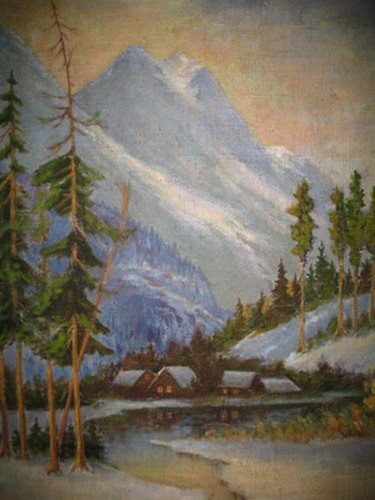Things You'll Need
Paper (acrylic)
or
Canvas (acrylic or oil)
1/4-Inch flat paint brush
Water (acrylic)
Linseed oil (oil)
Paint: burnt umber, Payne's gray, white, Prussian blue, Hooker's green

Pine trees give structure to a painting. When you paint pine trees or any natural object, use at least two colors on the paintbrush at a time. This will help you avoid a cartoon style effect by giving your work realistic texture and adding dimension. The following instructions work for oil or acrylic paints. Feel free to vary the colors to match your personal style. One great way to do this is by using complementary, or opposite, colors instead of similar ones.
Step 1
Start with the trunk. Pines typically have long, slender trunks with a slight bend to them. Load your paintbrush with brown, gray and white. Do not blend the colors. Turn the brush so the bristles create a vertical line. Dab the brush in vertical strokes to create the trunk, lifting slightly but not completely between strokes. The unmixed colors will create the texture of bark. Keep your wrist loose. If you are worried about mistakes, draw the trunk with a pencil first.
Video of the Day
Step 2
Use the same three unmixed colors to create the branches. Start with the paintbrush on the trunk and move it outward in short strokes. The branches should be longest at the bottom. They should grow shorter as they move up the tree so that they form a slightly irregular triangle.
Step 3
Clean the brush. Load it with blue and green paint. Do not mix the colors. Create small, overlapping strokes that begin at the branches and move out from them. It is OK to cover the branches partially or completely, depending on how full you want the foliage.
Tip
Paint your background first. This makes your trees look like they are in the front of the painting.
Warning
Oil paint dries slowly. Be sure to use it in a ventilated area, especially if you choose to clean your brush with turpentine instead of linseed oil.
Video of the Day